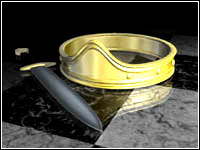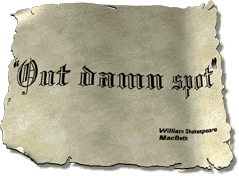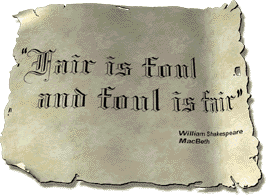| ||

Say "MacBeth", and the first thing that comes to mind is the famous play of the same name by English playwrite, William Shakespeare. The timeless story of a power-hungry Scottish nobleman who is driven by prophecy to commit murder and become King is a mainstay of high school English literature classes around the world. Few people realize, however, that there was a real King MacBeth, and it's about time his story was told....but first, the play. Shakespeare's MacBeth was first performed in 1606, three years after James 1 (James IV of Scotland) ascended to the throne following the death of Elizabeth I. Like Elizabeth, James was obsessed with witchcraft and his rule was marked by spectacular witch trials whose inevitable outcome was a guilty verdict followed by compulsory burning at the stake. Not surprisingly then, the play contains all sorts of interesting characters, including virtuous Kings and murderous noblemen, guilt ridden wives driven to suicide by nightmares and ghostly apparitions, and, of course, the prerequisite witches summoning up prophecy from the depths of evil.
It is true that MacBeth, then a Mormaer (Lord or Steward) of Moray, murdered King Duncan I in 1040. But the reasons why it happened are not clearly explained and other parts of the story are plainly untrue. Kingship in eleventh century Scotland was not for the faint-hearted. Viking marauders still threatened from their base in the outer islands and Scottish politics was marked by internal strife punctuated by the all too frequent murder of Kings and their potential heirs. The mayhem was largely due to the ancient practise of choosing Scottish kings called tanistry (or thanistry as in thane). Under tanistry, succession was not strictly heriditary: rather, noblemen chose kings from a large pool of potential kings called tanists - any one of whom may have a legitimate claim to the throne through ancestry or marriage. In theory, tanistry should have worked. But in practise, what often happened was the strongest and most cunning of the tanists would rise to power. As a result, the best person did not necessarily become King because tanistry encouraged open conflict as well as the assassination of reigning kings and other tanists. But when MacBeth murdered King Duncan I in Elgin, near Glamis Castle in 1040, it was generally seen as a good move. Duncan's rule in Scotland was not the golden age described in Shakespeare's MacBeth. Rather than the wise, benevolent King portrayed by Shakespeare, Duncan was described by Arthur M. Gunn as an "impetuous and spoiled young man whose six years of kingship brought glory neither to Scotland nor his family." In contrast, King MacBeth's seventeen year rule of Scotland between 1040-1057 was characterized by peace and tranquility. During his reign, MacBeth united south and north and brought a semblence of law and order to Scotland.
MacBeth's revenge murder in 1057 by Duncan's son Malcom - who returned from exile in England with the intention of taking back the throne - marked a turning point in Scottish history from which there was no looking back. With the full support of the English, Malcom III (also known as "Big Head" or "Canmore") became the new King of Scotland, ruling until 1093. Under Malcom's reign, Scotland began the transformation from a Celtic to an English culture and Roman Catholicism began to have a major influence on Scottish politics. And because of Malcom's English ties, from then on the English would not leave Scotland alone. But in true Scottish fashion, MacBeth won't let us forget. Glamis Castle, where Shakespeare set the nasty business of Duncan's murder by MacBeth, is reputed to have several ghosts. The castle, which is the childhood home of the Queen Mother, is apparently haunted by a White Lady, a Grey Lady, a boy servant and a Knight in Shining Armor who - rumour has it - likes to frighten small children in their sleep. MMJ, October 1999
| ||
|
| ||
Thursday, December 26th, 2019
Attention visitors: Tartans.com is back. Please note that this is a snapshot of the site as it existed nearly 20 years ago and you may encounter broken links; we are still combing through the site and correcting those as we find them. Please also note that some sections are currently not functional, primarily the discussion forums/clan chat boards.
|
** HOME - First Time Visitors - Glossary - - Contact Us ** Awards | Bibliography | Clan Calendar | Clan Chat | Clan Finder | History | Famous Scots | Genealogy | Great Hall of the Clans | Links | News and Features | Scots on the Net | Search | Site Map The Gathering of the Clans
Copyright 1995- Tartans.com - All Rights Reserved. |

 Contemporaries called Shakespeare's MacBeth "the Cursed Scottish Play", because of numerous mishaps during production. Had the real King MacBeth been alive, he probably would have cursed the play too - because its historical inaccuracies cast MacBeth as an evil plotter while portraying his enemies as innocent pillars of society.
Contemporaries called Shakespeare's MacBeth "the Cursed Scottish Play", because of numerous mishaps during production. Had the real King MacBeth been alive, he probably would have cursed the play too - because its historical inaccuracies cast MacBeth as an evil plotter while portraying his enemies as innocent pillars of society. And unlike many other Scottish Kings before him, MacBeth was so secure in his Kingship that he was able to go on a pilgrimage to Rome in 1050 and return to reign for another seven years unchallenged, which was a remarkable achievement given the times.
And unlike many other Scottish Kings before him, MacBeth was so secure in his Kingship that he was able to go on a pilgrimage to Rome in 1050 and return to reign for another seven years unchallenged, which was a remarkable achievement given the times.